Denis Valentinovich Manturov Minister of Industry and Trade of the Russian ...

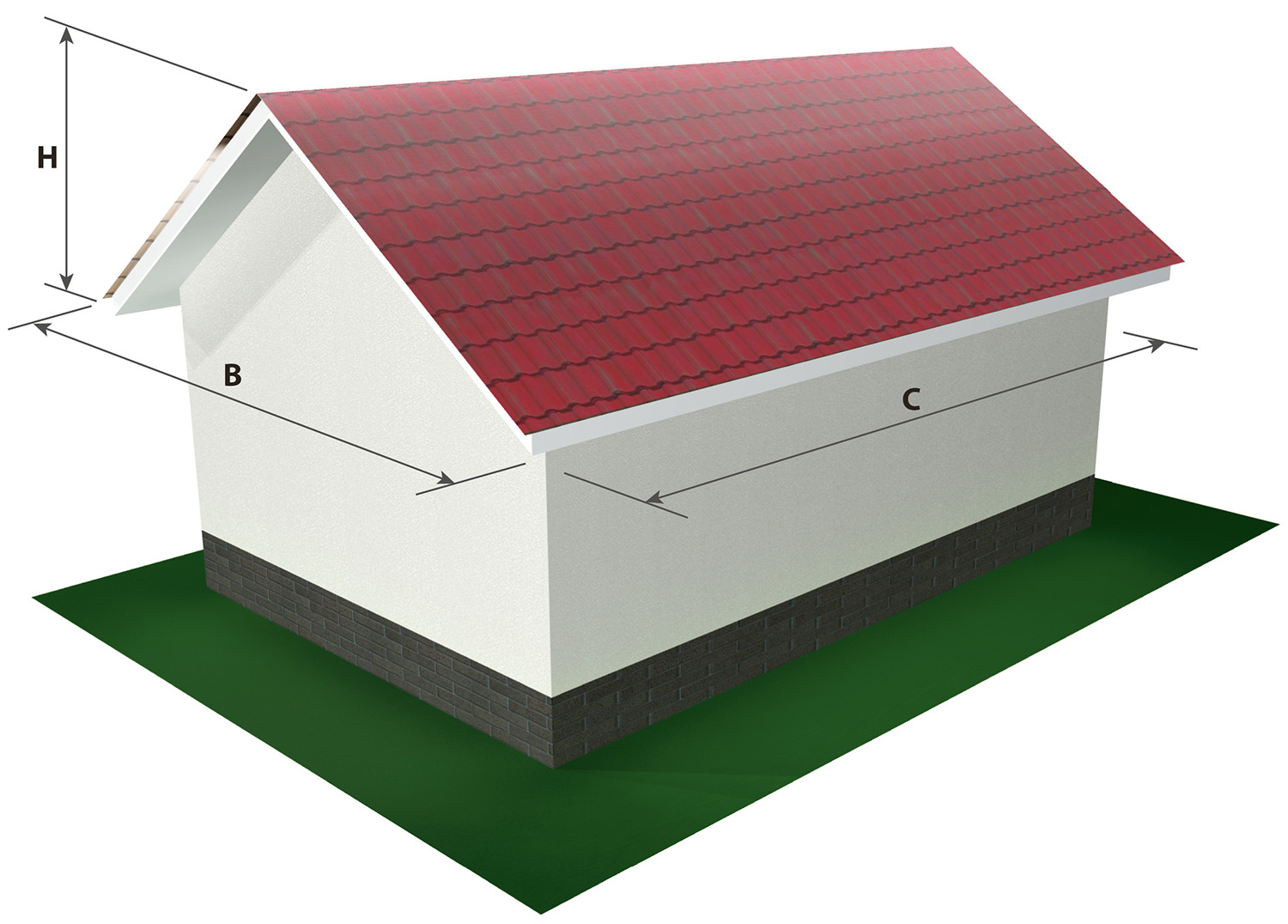
The construction of any house, regardless of its quadrature, number of storeys and fashionableness, does not begin with a foundation pit and foundation, but with the preparation of a project and calculations, among which the roof is among the most significant and requiring increased accuracy. It is also considered one of the most important elements of the building, and performs two important functions at once:
But it will turn out this way only if you have chosen the most suitable form, you know how to calculate the roof area of a house and perform the rest of the calculations, did not make any inaccuracies in measurements and mathematical actions, professionally realized your wishes.
Understanding how to calculate the roof area, knowing the area of the house, will be useful to you, first of all, in order not to be mistaken in the amount of material required for construction. The more accurately they are executed, the higher the chance of avoiding unnecessary financial costs.
First, decide on the type of roof to be built, because there are many modern architectural solutions: there are simple and complex, of the same type and combined - for every taste, if only the appearance of the building is unique and irresistible. Today there are different forms:
The shape chosen for the roof arrangement is always reflected in the construction project. When performing calculations, attention is also paid to what kind of roofing material the covering will be made (slate, metal tiles, etc.).
Directly to determine the general quadrature, you will need to take data such as:
The easiest way is to find out the area of a shed structure, which is usually chosen to cover outbuildings (barn, garage, facilities for breeding pets).
The shape of the pitched plane is the simplest - it is a regular rectangle, respectively, the area is equal to the length multiplied by the width, while to each side you need to add the size of the pediment overhang and the cornice (you can take the standard half a meter).

For residential buildings and cottages, gable structures are most often chosen, this option is often called "classic". There will be no problems with how to calculate the area of such a roof of a house with a calculator, because all calculations are based solely on the simplest basics from the trigonometry course taught in high school. Initially, the area of the pitched plane is determined, and then the resulting value is multiplied by "2", because there are two slopes in the design. But if the project provides for the construction of pitched planes with different sizes, then the areas of each of them are calculated separately and summed up.
For a visual representation, you can consider one of the calculation examples, for it we need the following initial data:
Substituting all the values in the formula, we get that the area of one pitched plane is equal to:
S = (10 + 2 * 0.5) * (5 + 0.5) = 66 sq. meters.
Considering that there are two slopes, we double the resulting value, as a result, we determine that the roof area will be 132 sq. meters.
As a rule, any structure contains chimneys and outlets of ventilation ducts, and can be equipped with windows. But their size is not subtracted from the resulting area.

Today, for the construction of the roof of a residential building, it is fashionable to choose four-pitched structures. Most often, if the dimensions of the building are proportional and square, the roof is made pyramidal. This variety is called "hip", in this case, each slope is an isosceles triangle, they are all connected at the top at a single point, and the base is a quadrangle. In this case, how to calculate the area of the hipped roof of a house with a calculator will not cause any difficulties, because you can apply a formula that assumes the calculation of the area of a triangle, then multiplied by "4". To find it, you need to multiply the width by the height and divide the result by two. Let's say we have the following data:
It is very important to take into account for this calculation that measurements are taken not along the perimeter of the structure, but along the eaves. Also, do not forget that the slope of the slope must be taken into account in the value of the slope height.
While figuring out how to calculate the area of a four-pitched roof of a house, you may be faced with the need to select calculations for a more complex structural type, called "hip". This is also one of the solutions popular today, used for the design of residential buildings, country cottages. This design consists of two end sides, in the form of isosceles triangles, and two lateral ones, made in the form of trapezoids. The calculation principle is based on determining the areas of a triangle and a trapezoid, multiplying each obtained value by "2" and then summing it up into a total result.
As already discussed, to find the area of a triangle, you need to multiply the width by the height and divide the result by "two". In the case of a trapezoid, it is also necessary to use the provided formula, in which the bases are summed up, the result obtained is divided by "two", and then everything is multiplied by the height of the sloping plane.
For a hip structure, it is imperative to pay attention to the presence and size of windows, chimneys, overhangs, parapets.
Among the undisputed leaders in popularity is the attic type. It is characterized by a sloping "broken" roof, which consists of two parts. The top in this case is shallow, and the bottom is steep, which makes it possible to form a spacious and capacious attic space, which is commonly called the "attic".
Understanding how to calculate the area of the attic roof of a house, at first glance it may seem that it is too difficult to do this, but in fact, the principle will be clear even to a non-specialist. First you need to draw up a construction plan with a clear indication of all known sizes, and then just break it down into the simplest geometric figures, finding the areas of which are still under the school curriculum in geometry lessons:
Having received the values \ u200b \ u200bof simple figures, they are summed up, and the final result will be equal to total area roofs. Do not forget at the same time that there are two sloping planes, and it is necessary to sum up the squaring of simple figures on both sides.
Also, always remember that all measurements must be taken from the extreme point of the eaves to the ridge. When measuring the foundations, always add a margin for the eaves and gable overhangs, leaving at least half a meter on them.

Thanks to the endless possibilities of the Internet, nowadays you can cope with the task much easier and faster, because such a convenient tool as online calculator, and everyone will be able to calculate the area of the roof of the house with its help.
To perform calculation actions, it is enough to go to the site and enter the data requested for calculation operations in a special form. Further, the system itself performs calculations and produces a finished result.
February 9, 2017
The strict geometry of roof coverings defines the way of calculating the total roof area as an arithmetically simple task. But the mass of various types of roof construction and the personal preferences of the owner of the home leave many questions and doubts about the right choice method of calculating the area.
The desire to organically fit the house into the surrounding landscape is dictated by the most elaborate roof designs. Tent, mansard, multi-gable projects complicate the calculations. So how can you reliably calculate the area of your roof? We will cover this issue in detail from the point of view of the final consumer of roofing.
The choice depends on how the roof space will be used. In the case of an auxiliary, technical room, the choice is usually stopped on a pitched roof. In the case of a residential attic, a mansard-type structure is chosen or, given the presence of natural light, a complex multi-gable roof is built.
Naturally, the roof area is significantly increased, and it will be more difficult to calculate it. Before you start designing a roof, you need to know what they are.
Based on the shape and number of slopes, roofs are divided into the following main types:
Such a variety of designs gives a wide scope for the owner's imagination and the ability to combine different types roofs in one building. Determining the area is a rather difficult technical task, but we will try to simplify it.
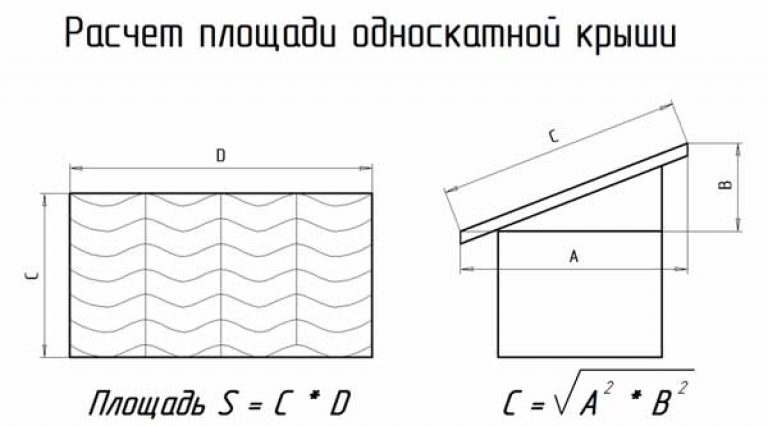
Before calculating the roof area, it is necessary to know in advance not only the dimensions of the roofing, but also the dimensions of the overhangs on the gables and cornices. Otherwise, it will not be possible to optimally arrange the sheets and calculate the required stock of material.
Buying additional coverage in case of its shortage, you run the risk of purchasing it from another batch, which can lead to a discrepancy in colors.
When determining the area of \ u200b \ u200bthe roof of a house, it is necessary to prepare a number of tools and devices in order to make detailed drawing... On its basis, the true area is found, which may differ from simple rectangular shapes. For measurements you will need:
The area of the slope, provided it is square, is calculated by simply multiplying the length by the width of the roof. The parameters are fixed taking into account the pediment and eaves overhangs, then the amount required is calculated roofing material without losing sight of the overlap correction.
The length of the slope can also be calculated using the Pythagorean formula, measuring the height of the ridge and the width of the house, taking into account the eaves overhang. If the roof is not strictly rectangular, we calculate the area by summing the area of the rectangle and two triangles.
When the house has a gable roof, it is necessary to calculate the quadrature of each slope separately and sum them up to calculate the overall result.
Complex roofs include multi-gable, hip and domed types of structures, the square of which is the sum of the area of various geometric shapes. As an illustration, you can consider the calculation of the quadrature of the hip roof. It consists of two isosceles triangles and two trapezoids.
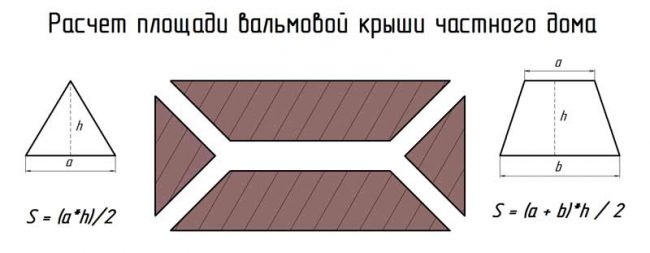
The area of a triangle is calculated using the following formula:
S 1 = (a x h): 2,
where S 1 is the area of the triangle, a is the length of the base and h is the height of the triangle.
The area of the trapezoid is calculated using the following formula:
S 2 = [(a + b) x h]: 2,
where S 2 is the area of the trapezoid, a and b are the base of the trapezoid, and h is its height.
Thus, the total square of the hip roof will be equal to:
S total = (S 1 + S 2) x 2
In the case of calculating the quadrature of more complex roofs, the method of splitting into simple geometric shapes also fully justifies itself. The drawing made after the measurement will allow you to accurately calculate the squaring of the fragments and, by adding, get the overall result. If a slope or a fragment of the roof has the shape of a parallelogram, you can calculate the overall result using the formula:
where S is the area of the fragment, a is the length of the side and h is the height of the parallelogram.
When calculating the total amount of coverage, it must be borne in mind that in triangular and trapezoidal sections of the roof, material losses can reach 20% or more.
Hip roofs consist of four isosceles triangles, the quadrature of which is summed up to obtain a general result. Dome roofs can consist of individual sheets of complex shapes, but nevertheless they are calculated by reduction to separate geometric components for a simple calculation of the amount of coverage. It must be said separately that in the case of using flammable roofing materials, it is necessary to ensure workplace fire protection means.
When calculating the required amount of roofing material, it is not necessary to take into account the outlets of ventilation, chimneys and window openings, this reduces the risk of a lack of coverage, since waste on complex roofs can be from 8 to 30%.
On a detailed drawing of a multi-gable roof, individual geometric shapes must be carefully measured, which can be:
The position of these figures on the roof should be clearly and unambiguously recorded on the drawing, which will allow in the future to draw up a scheme for cutting the coating in relation to its overall dimensions... This will avoid large financial losses and optimally lay the roof.
Calculated separately, it is best to do this with the participation of a qualified seller who can check yours and give additional recommendations. In addition, there are special calculators on the Internet for calculating the area of complex roofs.
Thus, we talked about the correct calculation of the area of roofs of various types. Carefulness and thoroughness of measurements, as well as the drawn up installation diagram, will allow you to avoid miscalculations and gross errors. And then the roofing work will take place without financial loss and will bring joy.
Construction is an exact science that requires correct calculations for the construction of any object. So professional builders need to know how to calculate the roof area. Some of the calculations can be performed using electronic calculators offered by various sites. However, a truly accurate calculation can only be done "manually", starting from a specific object.
How to calculate the roof correctly? The concept of such calculations includes height, area, slope, the amount of materials required. Moreover, these figures need to be known not only for theoretical calculations and compliance with project documentation. Knowing the exact numbers will help you understand how much roofing material you may need. And this will make it possible to save on the purchase of unnecessary volume. Such calculations help to determine the choice of material for the roof, taking into account its characteristics.
It is impossible to say unequivocally how to calculate the roof of a house, since the scheme of such calculations depends on the architecture of the building. So the combined roofs, used most often for outbuildings, are flat, therefore, they are easy to calculate. And the attic can be of various kinds: gable, single-pitch, multi-gable, hip and half-hip, hip, and for each type it is necessary to apply its own counting method.
Most often, gable roofs are erected in individual houses built without any special frills, therefore, we will consider, first of all, how to calculate the gable roof of a house. Moreover, such calculations are much easier to do than, for example, the calculation of a hip roof.
The calculation of the roof of the house is needed in order not only to control the correctness of the project, but also to assess the ability of the roof to withstand the materials laid on it, in conjunction with the weight of precipitation and possible overloads
Without a roof slope, precipitation will accumulate on the roof. The calculation of the slope gives an accurate idea of the height to which the ridge should be raised, allows you to find out the amount of material for the roof, how to carry out the installation and at the same time comply with the requirements of the manufacturer of the selected material.
The tilt angle can fluctuate between 11 ° -70 °, but making it more than 45 ° is impractical. If the climate is warm and dry, a large slope is not needed. At the same time, an area with cold and snowy winters requires a greater slope. At the same time, an angle of 45 ° will relieve the owners of the house from the snow load, but at the same time will increase the wind pressure. In this case, it is necessary to strengthen the crate and rafters. In addition, a large slope will require more roofing materials.
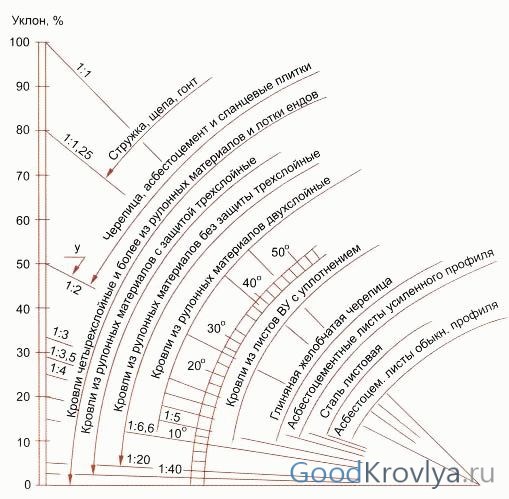
The value of the slope of the roof, depending on the selected roofing
The angle of the slope on gable roofs largely depends on what material is chosen for roofing work. So for metal, it will fluctuate within 15-27 °, roll materials require the same inclination. And for slate, 27 ° is also suitable.
The calculation of the roof slope is shown in the table. The slope can be measured both in percent and in degrees, in the table the data is indicated in two units of measurement. The last column contains the figures for the roof lift coefficient. This coefficient is equal to the rise of the skate by 1 meter.
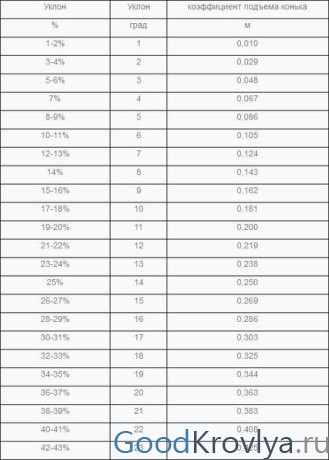
Determination of the slope of the roof. Part 1
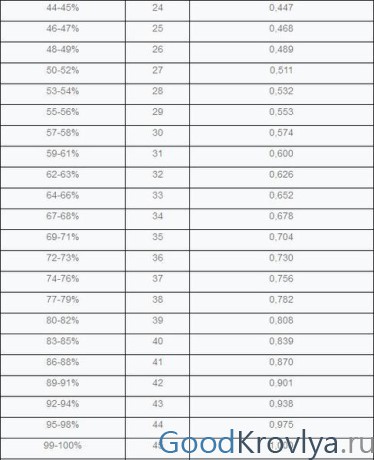
Determination of the slope of the roof. Part 2
Calculation example
For a house with a width of 8 m and a roof with a slope of 40 °, we calculate the height of the roof. To do this, half the width (4 m) must be multiplied by the ridge factor. For 40 °, it is 0.839.
0.839 * 4 = 3.356. This means that the rise of the ridge of such a house will be 3.356 meters.
In order to find out how much roofing material needs to be prepared, it is imperative to know the roof area.
Important!
The choice of the gutter system, the dimensions of the gutters and downpipes depend on the area of the roof and the angle of its inclination. So, a slope with an area of up to 60 m 2 can do with a trough with a diameter of 125 mm, and from an area of 100 m 2, water is discharged by a trough with a diameter of 150 mm. The calculation of downpipes is carried out taking into account the fact that each downpipe provides an effective drain from every 10 m of the gutter.
The easiest way to do such calculations is for gable roofs consisting of two parallelograms. We recall the basics of geometry and multiply the height of the parallelogram (a) by its width (b) and add the resulting figure:
ab + ab = 2ab = S total
Of course, much more material will be required, if only due to the fact that the sheets will overlap.
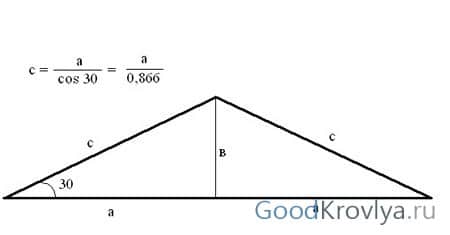
Calculation of the area of a gable roof at an angle of inclination of 30 degrees
Calculating the area of a hipped roof is more complicated. As a rule, hipped roofs are either hip or hipped. Let's decompose the surfaces that make up the roof into simple shapes. For the hip, it will have 2 trapeziums and 2 triangles, and for the hip one - 4 triangles.
The area of an equilateral triangle is equal to half the product of the width of the base of the triangle (a) and its height (h):
We get the actual area of one of the triangles. If this is a hipped roof, with equal sides, then the figure is multiplied by 4:
However, the option with absolutely equal sides of the building is extremely rare, which means that the lower sides of the triangles along which we calculate the area will not be equal. Therefore, most often the calculation according to the specified formula must be made for each slope separately, and then add the results obtained:
S1 + S2 + S3 + S4 = S total
This is how we calculated the area of the hipped roof. Now we will do the same with the hip, consisting of triangles and trapezoids. The area of the trapezoid is equal to the sum of the length of the base (a) and the length of the apex of the trapezoid (b), multiplied by its height (h), and divided by 2:

Just as in the first case, we calculate the area of the triangles. The total area is obtained by summing the areas of all trapezoids and triangles:
2Strapeze + 2Striangle = S total
It rarely happens that it is necessary to calculate the area of each trapezoid and each triangle separately, and then summarize the results.
Of course, this method is only suitable if you have the exact dimensions of each slope. When the hands have only a top view (projection), the area of the figures depicted (the same trapezoids and triangles) will not only have to be multiplied to obtain real numbers in accordance with a given scale, but also multiplied with the cosines of the angle of inclination.
Important!
When calculating the roof area, one must not forget that the roof area is calculated not along the edges of the structure, that is, along the walls, but along the eaves.
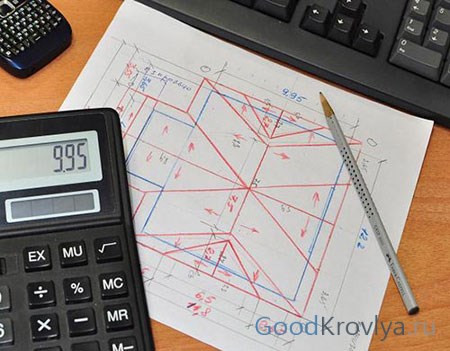
Calculation of the area will be required not only for the "correct" performance of roofing work, but also for drawing up an estimate for the purchase of building materials
If you decide to independently calculate the amount of material required, first you need to decide on the choice of material and its dimensions.
Let's take the following initial data:
With such parameters, the roof area will be 114 m 2 = 2 x 9.5 x 6. The material of the cover will be a metal tile with a polyester interprofile.
For calculations, you will need data on the width and length of metal sheets, which depend on the type of interprofile:
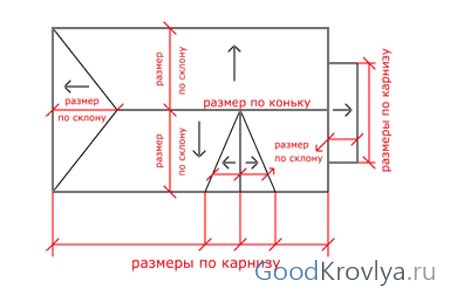
To calculate the amount and cost of materials for roofing, you need to know the exact dimensions of the roof of the house
The calculation of the required number of sheets for the width of the slopes is carried out by dividing 9.5 m - the length of the ridge, by 1.1 m - the useful width of the sheet. As a result, we get 8.63 sheets = 9.5 / 1.1. We round the value up, as a result we get 9 sheets.
Then, using the example of a 1-wave sheet, we count the number of sheets required along the length of the ramp. 6 m - the length of the slope, divided by 0.35 m - the useful length of the sheet. As a result, we get 17.14 sheets. In this case, rounding can be done downward, since the remainder will be closed by an unspent extreme overlap. Expressed in sheets, the length result will look like 6.09 = 0.14 + 0.35 x 17.
Since there are 2 slopes, the number of sheets is also multiplied by 2. For the roof shown in the example, 18 sheets of different lengths are required:
In cases of using metal tiles with a different number of waves, the useful length indicator should be replaced in the calculations.
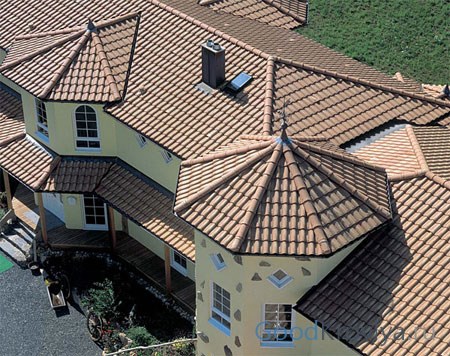
Complex roofs require a professional approach
It is impossible to neglect the calculations of the roof during construction, as this can lead not only to cost overruns, but also to damage or even destruction of the roof during the operation of an already built house. And if the roof is gable, you can do it yourself. But complex roofs require a professional approach.
The same applies not only to cutting the material, but also to the process of calculating the roof. Even if gable roofs require a serious approach to calculations (which, at first glance, may seem quite simple), then intricate surfaces, roofs with many broken surfaces and the intersection of various planes require a truly professional approach. And in this case, saving and the desire to complete everything without resorting to outside services, often leads to unpleasant consequences. The best option there will be an appeal to professionals with extensive experience in construction. Houses are not built for a year or two, so it is hardly worth saving on the process of their construction.
The problem of how to calculate the area of a pitched roof arises not only when designing a new house. Carrying out overhaul roofs with complete dismantling of the rafter system poses the same tasks for the builders. The ability to carry out calculations of any level of complexity of all elements of pitched roofs is necessary both for monitoring the correctness of the project, and for assessing the strength parameters of the structure being erected, as well as for the accurate purchase of all materials required for construction or repair.
Gable roofs are the most common type. They can be found almost everywhere, but they are most widespread in the design of residential buildings.
When describing a roof of such a configuration, they are usually limited to the following characteristics:
For information ! These parameters are typical for one-story buildings. For houses with a higher number of storeys, there are projects of gable roofs with different lengths and widths of inclined surfaces.
The classic pitched roof is a neat triangle
Drawing up a house project allows you to embody on paper the idea that will be further implemented in the specified territory. On the basis of this documents, all basic calculations are carried out, including roofing materials.
The design of a gable roof provides for the introduction of a main parameter, based on which all basic indicators will be calculated. This characteristic is the angle of inclination of the slope.
When considering a typical roof configuration with two inclined planes, the angle can vary up to 45 degrees, while the minimum roof slope angle is assumed to be 11 degrees. Thus, it turns out that the steepness of the surface can vary over a wide range, changing the performance of the "fifth facade".
Important ! The angle of the roof slope is a value inversely proportional to climatic loads (rain, wind, snow, etc.).

The angle of the roof slope can range from 11 to 45 degrees
In addition, when deciding what angle of inclination will be at the roof of the house, one should not forget about such a factor as windage. Sailability is the susceptibility of the roof structure and the roof as a whole to wind currents. That is, the more intense the rise of the roof, the more it is exposed to the wind load, the more attention should be paid to the arrangement of the rafter system and the lathing.
Already at the design stage, you need to understand what types of calculations will be in demand in the future:
The calculation of a gable roof begins with the derivation of digital indicators that characterize:
It is possible to find out exactly how these factors will affect the weight of the roof thanks to special formulas. According to the corresponding SNiP, they take into account all the features of the regional location of the house under construction, which means that the load standards are most accurately determined. Also, when calculating these indicators, the angle of inclination of the roof slope surface is also taken into account.

Wind loads on the roof arising from the pressure of air masses
As for the weight of the roof, it is calculated quite simply, since its value is influenced by all the materials used for insulation. Data on the load of any element from the layers of the roof are available in the accompanying documentation and technical description for construction products.
Important ! The value, which even the most experienced craftsmen do not recommend, is 50 kg per square meter.
Catching up self-development diagrams of the rafter system, you involuntarily have to calculate all its parameters. You will learn how to calculate the height of a gable roof, its area and other data. In terms of importance, the calculations of the rafter system are equated to the calculations of the roofing loads.
The reason for this comparison is that the rafters act as a connecting link and help redistribute the load from the entire roof structure to the load-bearing walls of the house. Also, the knowledge of how much weight the rafters should withstand are decisive in the selection of material for their installation.
Important ! The resulting calculated value should be increased by 50%. This will form a good margin of safety for the entire rafter structure.

The task of the rafter system is to distribute the weight of the roof onto the load-bearing walls of the house
There are usually two criteria that are guided when calculating a rafter structure:
In addition to load indicators, the calculation of rafters includes determining the size of their step and the need to use additional structural elements.
The lathing is a necessary element of any roof. It is thanks to this design that the correct laying of the roofing material, its durability and reliability during operation is ensured.
The lathing can be different in configuration, but they are usually distinguished:
For information ! The step of the lathing is the permissible interval between the beams, on which the roofing material lays down most optimally.

The type of pitched roof sheathing must be chosen based on the type of roofing material
In order for the calculation and formation of the lathing to be carried out without errors, it is very important to first know how to calculate the area of the pitched roof. Also, this information will be useful when calculating the roofing material for installation work.
The lathing and all its characteristics are determined by the type of roof, the material of the rafter system, as well as the type of roof. So, for example, the use of soft roll coverings is possible only with a continuous crate. The materials for the manufacture of the lathing are a bar with a section of 50x50 mm or boards with a thickness of 2-2.5 mm.
So, the defining parameters of any gable roof are the angle of inclination of the planes and the total surface area. If the first indicator is a planned value, then the second characteristic is usually determined by calculation methods.
To determine the total roof area, one of two methods is often used:
When choosing the second option, it is worth noting that such work requires thoroughness and accuracy.
Important ! Without information about the roof area, it is impossible to make an estimate for the work.
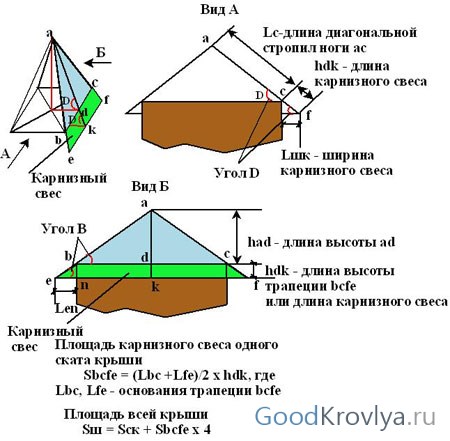
In order for the calculation to be as accurate as possible, a certain algorithm is used:
It is worth noting that even such a simple calculation is often difficult. Therefore, if this type of work is not familiar, then it is better to use the method of sequential actions. Its essence lies in breaking the entire roof area into simple geometric shapes, performing arithmetic operations with known numbers and summarizing the results obtained.
Building a house is somewhat reminiscent of a good constructor, and computational work is like school geometry lessons. However, in reality, things are not so simple. The construction or renovation of a house should not be regarded as frivolous work or as educational construction activities. It is advisable to engage in construction for people with good experience in such work or with a serious theoretical base. If you choose between these categories, then preference should be given to professional practitioners.

The roof, built with the help of specialists, will be reliable in operation
When construction specialists are engaged in the construction of a house, then you can be sure that all work will be carried out at a very high quality level. And this means that the built house will stand for a long time, do not require unjustified repairs and delight residents with a cozy atmosphere, regardless of the weather outside the window.